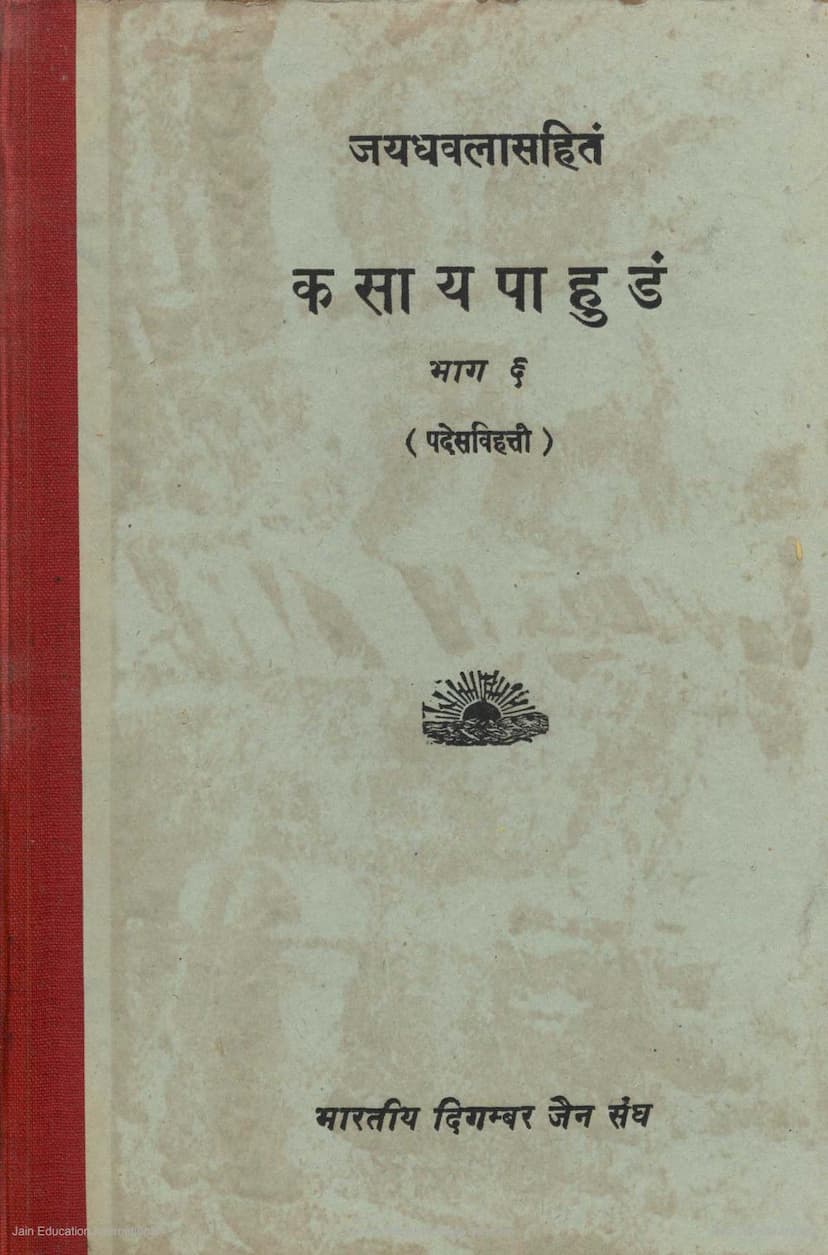Kasaypahudam Part 06
Added to library: September 2, 2025

Summary
This is a summary of Kasaypahudam Part 06 (Pradesh Vibhakti), authored by Gundharacharya, with commentary by Yativrishabhacharya (Churni Sutra) and Jayadhavala by Virasenacharya. The English summary is based on the provided text, which details the fifth chapter, Pradesh Vibhakti (Distribution of Karma Particles).
Overall Structure and Content:
This volume is part of a larger Jain text, "Kasaypahudam," which deals with the subtle aspects of karmic bondage and liberation according to Digambara Jain philosophy. Part 06, specifically focusing on "Pradesh Vibhakti," delves into the intricate classification and distribution of karmic particles (pradesh). It meticulously analyzes these distributions through various "Anuyogadwaras" (modes of inquiry or analytical categories).
Key Concepts and Chapters/Sections Covered:
The text is structured around the classification of "Pradesh Vibhakti" into two main types:
-
Moolprakriti Pradesh Vibhakti (Distribution of Particles of Root-types of Karmas): This section discusses 22 Anuyogadwaras related to the fundamental karmic classifications. These include:
- Bhagabhag (Proportionate Distribution)
- Sarvapadesh Vibhakti (All Particles Distribution)
- Nosarva Pradesh Vibhakti (Non-all Particles Distribution)
- Utkrishta Pradesh Vibhakti (Highest Distribution)
- Anutkrishta Pradesh Vibhakti (Not Highest Distribution)
- Jaghanya Pradesh Vibhakti (Lowest Distribution)
- Ajaghanya Pradesh Vibhakti (Not Lowest Distribution)
- Sadiya Pradesh Vibhakti (Beginning-with Particles Distribution)
- Anadiya Pradesh Vibhakti (Beginning-less Particles Distribution)
- Dhruva Pradesh Vibhakti (Permanent Particles Distribution)
- Adhruva Pradesh Vibhakti (Non-permanent Particles Distribution)
- Ekajivena Samittvam (Ownership by a Single Soul)
- Kala (Time)
- Antara (Interval)
- Nanajivehi Bhangavichaya (Combination of Aspects by Many Souls)
- Pariman (Quantity)
- Kshetra (Space)
- Sparshana (Contact/Reach)
- Kala (Time - again, likely a different aspect)
- Antara (Interval - again)
- Bhava (Mental State)
- Alpabahutva (Less-more Analysis)
- Additionally, it mentions Bhujagar (eating/enjoying), Padnikshep (placement of feet), Vriddhi (increase), and Sthana (state/place) as further Anuyogadwaras.
-
Uttar Prakriti Pradesh Vibhakti (Distribution of Particles of Subsequent-types of Karmas): This section analyzes the distribution of particles for the subtler "Uttar Prakritis" (derived or subsequent karmic types). It covers similar Anuyogadwaras but applies them to these specific types, particularly focusing on the Mohaniya (deluding) karma and its subdivisions like Kshetras (Kashayas - passions) and Nokshetras (minor passions).
Methodology and Detail:
The text, particularly the Jayadhavala commentary, is known for its extreme depth and logical rigor. It employs detailed analytical methods to determine the distribution of karmic particles across various classifications:
- Naya (Nay): The analysis considers both Dravyaarthik Naya (substance-centric perspective) and Paryayaarthik Naya (state-centric perspective).
- Ogha and Adesha (General and Specific Cases): The distribution is analyzed in general (Ogha) and then in specific contexts (Adesha) across different types of souls, lifetimes, and environments (hells, heavens, animal realms, human realms).
- Mathematical and Logical Reasoning: The text uses complex calculations and logical deductions to determine the precise proportions and quantities of karmic particles. This includes concepts like "Gopuchha" (cow's tail, referring to a specific distribution pattern) and "Viralan" (arrangement or spreading).
- Inclusion of Commentary: The Jayadhavala commentary by Virasenacharya is crucial for explaining the subtleties of Gunadharacharya's original text and Yativrishabhacharya's Churni Sutras.
Publisher and Context:
The publisher is the Bharatiya Digambar Jain Sangha, indicating that this is a publication within the Digambara Jain tradition. The text is presented as part of a series aimed at making these philosophical and scriptural works accessible, often with Hindi translations and commentaries. The publication date is given as Vira Samvat 2484 (1958 A.C.), suggesting a historical effort to preserve and disseminate these texts.
Specific Examples and Complexities:
The text goes into immense detail, for instance, when discussing the distribution of Mohaniya karma. It outlines how the particles are allocated based on factors like:
- Yoga (activity of mind, speech, and body): The intensity and nature of yoga influence the type and quantity of karmic particles.
- Kashaya (passions): The strength and type of passions (Krodha, Mana, Maya, Lobha) determine the distribution.
- Time and Space: The duration of conditions and the spatial location are also considered.
- Life Span and Rebirth: The processes of transmigration and the conditions in different lives are analyzed for their impact on karmic distribution.
The text also highlights the meticulousness of Jain logic by addressing potential contradictions and offering resolutions based on different interpretations of Nayas or the context of the scripture. The detailed explanations of how various karmic residues are calculated and allocated reflect the profound level of spiritual science achieved in ancient Jainism.
In essence, Kasaypahudam Part 06 is a highly technical and philosophical treatise on the quantitative and qualitative distribution of karmic particles according to Digambara Jainism, explained through a detailed breakdown of various analytical categories and applied to different states of existence.